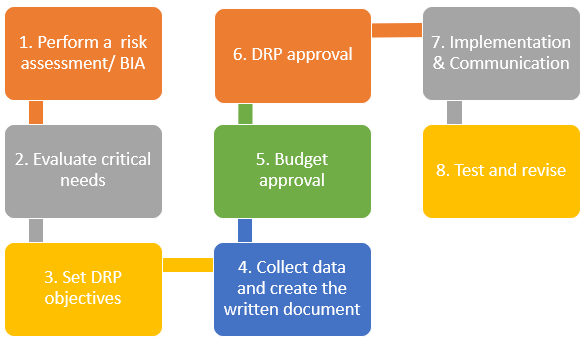
Here is an 8-step step-by-step guide to help you through the process of creating a disaster recovery plan (DRP) for your business.
Step 1: Perform a Risk Assessment/ Business Impact Analysis

A disaster recovery plan should start with a business impact analysis (BIA) and a risk assessment that addresses the relevant potential disasters. Tasks to carry out here are:
• Analyze all functional areas of the organization. This will help you identify possible consequences of a disaster, such as data loss or leakage.
• Assess risks and define suitable mitigation measures. Evaluating risks and setting mitigating measures can help businesses recover critical business operations in a disaster. This would allow continuity even while IT teams address the incident.
• Establish geographical and infrastructure risk factors. A risk analysis should factor in high-risk assets to enable organizations to prepare a suitable recovery strategy for these events. Ask yourself – do you need cloud backup? Will a single disaster recovery site suffice, or do you need multiple locations? Who is allowed access? And so on.
Step 2: Evaluate Critical Needs

Once you have completed a risk assessment, you need to evaluate the critical needs of each department/function and determine priorities for operations and processing. Create written agreements for predetermined alternatives and specify the following:
• Special security procedures
• Availability, cost, and duration
• Guaranteed compatibility
• Hours of operation
• Scenarios that would constitute an emergency for your organization
• System testing
• A procedure for notifying users of system changes
• Personnel requirements
• Specifications of hardware required for critical processes
• Service extension negotiation process
• Any relevant contractual issue
Step 3: Set Disaster Recovery Plan Objectives

Here, you need to define your disaster recovery plan objectives:
• Create a list of mission-critical operations needed for business continuity – when creating your list, decide which systems, applications, data, user accesses, and equipment are needed to support these operations.
• Document the RTO and RPO for each critical asset. Consult with staff at various levels and management to determine the impact of interruption of different assets for one minute, one hour, one day, and so on. Use this information to determine your RTO and RPO.
• Assess service level agreements (SLAs) – all your objectives should take into consideration SLAs guaranteed to any stakeholder, including users, clients and other parties.
Step 4: Collect Data and Create the Written Document

A relevant disaster recovery plan is based on collecting the right data. At this stage, collect:
• Lists – include critical contact information lists, master vendor lists, backup employee position listings, notification checklists and master call lists.
• Inventories – include communications equipment, documentation, data center computer hardware, forms, microcomputer hardware and software, insurance policies, office equipment, workgroup hardware, and off-site storage location equipment.
• Schedules – include software and data files backup or retention schedules.
• Procedures – include all procedures defined for system restore or recovery.
• Locations – include all temporary disaster recovery locations.
• Documentation – include any relevant inventories, materials, and lists.
Organize and include this data in a written, documented plan.
Step 5: Budget Approval
Present disaster recovery plan implementation options to management that reflect different budgets. Your best case scenario may have the best RTO/RPO and support more critical services but not be within the company’s budget. Therefore, you will need to allow management to decide on the right balance between risk and investment in DR technology.
Step 6: DRP Approval

Based on feedback from management, create a final draft of your disaster recovery plan and get a final approval and sign-off from management on the plan.
Step 7: Implementation & Communication

Invest in all necessary equipment and implement your DR plan. Then, circulate your disaster recovery plan document to the DR team, management and any other parties who will be involved with or affected by your disaster recovery procedures.
Step 8: Test and Revise

Finally, don’t just prepare the disaster recovery plan and then put it away on a shelf! You must regularly test and revise the disaster recovery plan to ensure it remains relevant. Testing will help to:
• Confirm your organization is adopting feasible, compatible backup procedures and facilities and that they are sufficient to meet your RTOs and RPOs.
• Identify areas in the disaster recovery plan that need review or updating.
• Train your staff/team to ensure they are well prepared to implement the plan.
• Prove the value of your plan and your organization’s ability to withstand disasters.
You can carry out disaster recovery plan tests in the form of:
• Disaster recovery plan checklist tests
• Parallel tests
• Full interruption tests
• Simulation testing exercises
Before running the test, you must determine the criteria and procedures for testing your disaster recovery plan. Ideally, you should perform this test outside normal business hours to minimize or avoid disrupting critical business processes. After deciding on a test, conduct a structured walk-through or an initial dry run and correct any issues.
Contact us today for your Disaster Recovery as a Service (DRaaS) solution.